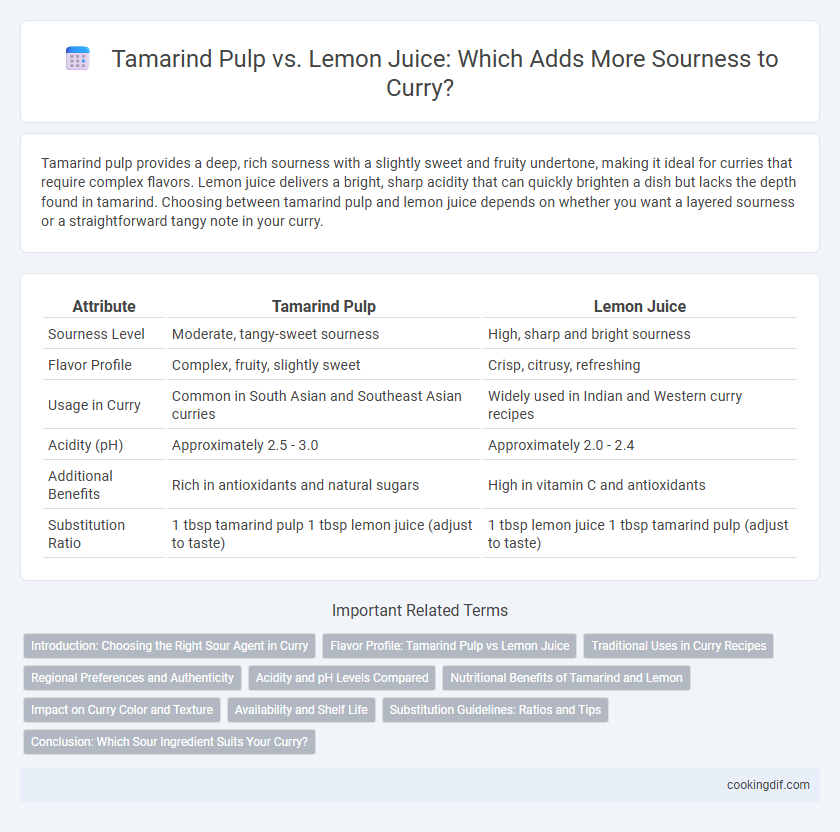Tamarind pulp provides a deep, rich sourness with a slightly sweet and fruity undertone, making it ideal for curries that require complex flavors. Lemon juice delivers a bright, sharp acidity that can quickly brighten a dish but lacks the depth found in tamarind. Choosing between tamarind pulp and lemon juice depends on whether you want a layered sourness or a straightforward tangy note in your curry.
Table of Comparison
| Attribute | Tamarind Pulp | Lemon Juice |
|---|---|---|
| Sourness Level | Moderate, tangy-sweet sourness | High, sharp and bright sourness |
| Flavor Profile | Complex, fruity, slightly sweet | Crisp, citrusy, refreshing |
| Usage in Curry | Common in South Asian and Southeast Asian curries | Widely used in Indian and Western curry recipes |
| Acidity (pH) | Approximately 2.5 - 3.0 | Approximately 2.0 - 2.4 |
| Additional Benefits | Rich in antioxidants and natural sugars | High in vitamin C and antioxidants |
| Substitution Ratio | 1 tbsp tamarind pulp 1 tbsp lemon juice (adjust to taste) | 1 tbsp lemon juice 1 tbsp tamarind pulp (adjust to taste) |
Introduction: Choosing the Right Sour Agent in Curry
Tamarind pulp and lemon juice are two popular sour agents used in curries, each imparting a distinct flavor profile essential for balancing spices. Tamarind pulp offers a deep, tangy, and slightly sweet sourness that enhances rich, slow-cooked dishes, while lemon juice provides a bright, sharp acidity ideal for lighter, more vibrant curries. Selecting the right sour agent depends on the desired taste intensity and the curry's regional authenticity, influencing the overall depth and complexity of the dish.
Flavor Profile: Tamarind Pulp vs Lemon Juice
Tamarind pulp offers a rich, tangy sourness with subtle sweet undertones, enhancing the depth and complexity of curry dishes. Lemon juice provides a bright, sharp acidity that adds freshness and a clean citrus note, cutting through rich flavors. The choice between tamarind pulp and lemon juice influences the curry's overall flavor profile, with tamarind contributing a warm, mellow sourness and lemon juice delivering a crisp, vibrant tartness.
Traditional Uses in Curry Recipes
Tamarind pulp is a staple souring agent in South Indian and Southeast Asian curries, valued for its rich, fruity tang that enhances the depth of flavors in dishes like sambar and fish curry. Lemon juice is commonly used in North Indian curries for its bright, sharp acidity that freshens creamy gravies such as butter chicken or dal makhani. Traditional recipes often choose tamarind pulp for slow-cooked curries requiring mellow sourness, while lemon juice suits quick-cooked preparations needing an immediate citrus punch.
Regional Preferences and Authenticity
Tamarind pulp delivers a rich, tangy sourness favored in South Indian and Southeast Asian curries, creating an authentic depth of flavor integral to traditional recipes. Lemon juice, with its bright, sharp acidity, is commonly used in North Indian and some Western curry adaptations, offering a fresher yet less complex sour taste. Regional culinary practices dictate the choice between tamarind pulp and lemon juice, emphasizing authenticity and the preservation of cultural flavor profiles in curry dishes.
Acidity and pH Levels Compared
Tamarind pulp has a pH ranging from 2.5 to 3.5, providing a moderate acidity ideal for adding depth without overwhelming sourness in curries. Lemon juice is more acidic, with a pH between 2.0 and 3.0, delivering a sharper, more pronounced sour flavor that brightens dishes instantly. Choosing between tamarind pulp and lemon juice depends on the desired acidity strength and culinary balance in the curry recipe.
Nutritional Benefits of Tamarind and Lemon
Tamarind pulp offers a rich source of antioxidants, vitamins B and C, and essential minerals such as magnesium and potassium, enhancing the nutritional profile of curry dishes. Lemon juice provides high vitamin C content, boosting immune function and aiding iron absorption while adding a bright, tangy flavor. Both ingredients impart distinct sourness levels, with tamarind delivering a deeper, fruitier tartness and lemon juice offering a sharper, zesty acidity.
Impact on Curry Color and Texture
Tamarind pulp imparts a rich, deep brown color to curry, enhancing its visual appeal and thickening the texture through its fibrous content. Lemon juice contributes a bright, vibrant acidity that lightens the curry's color without significantly altering its consistency. The choice between tamarind pulp and lemon juice influences both the curry's sourness profile and its overall appearance and mouthfeel.
Availability and Shelf Life
Tamarind pulp is widely available in Asian and Indian grocery stores and has a longer shelf life, often lasting several months when refrigerated due to its concentrated, paste-like form. Lemon juice, while commonly found in most supermarkets and offering a fresh, bright acidity, has a shorter shelf life and typically needs to be used within a week or two when refrigerated. For curry recipes requiring consistent sourness and extended storage, tamarind pulp provides a more convenient and durable option compared to lemon juice.
Substitution Guidelines: Ratios and Tips
When substituting tamarind pulp for lemon juice in curry recipes, use a ratio of approximately 1:1 for sourness intensity, but adjust to taste since tamarind has a deeper, fruitier tang. Begin with one tablespoon of tamarind pulp to replace one tablespoon of lemon juice and modify based on the dish's flavor profile and desired acidity level. Keep in mind tamarind is less acidic but sweeter, so reducing any added sugar in the recipe can help maintain balance.
Conclusion: Which Sour Ingredient Suits Your Curry?
Tamarind pulp delivers a deep, earthy sourness that enhances rich, slow-cooked curries with its complex fruity undertone, making it ideal for dishes like South Indian sambar or Thai curries. Lemon juice offers a brighter, sharper acidity that works well in lighter, quick-cooked curries, providing a fresh zing without overpowering delicate flavors. Choosing between tamarind pulp and lemon juice depends on the curry's cooking time and flavor profile, with tamarind suiting robust, long-simmered recipes and lemon juice complementing bright, vibrant dishes.
Tamarind pulp vs Lemon juice for sourness Infographic

 cookingdif.com
cookingdif.com